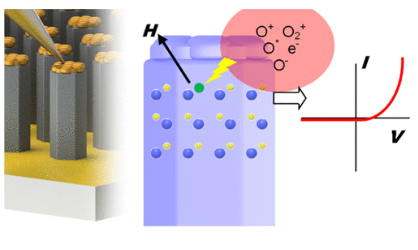
-
- to
Here you will find the paper by Vincent Consonni
"Polarity-controlled growth of ZnO by chemical bath deposition provides a method for controlling the crystal orientation of vertical nanorod arrays. The ability to define the morphology and structure of the nanorods is essential to maximizing the performance of optical and electrical devices such as piezoelectric nanogenerators; however, well-defined Schottky contacts to the polar facets of the structures have yet to be explored. In this work, we demonstrate a process to fabricate metal–semiconductor–metal device structures from vertical arrays with Au contacts on the uppermost polar facets of the nanorods and show that the O-polar nanorods (∼0.44 eV) have a greater effective barrier height than the Zn-polar nanorods (∼0.37 eV). Oxygen plasma treatment is shown by cathodoluminescence spectroscopy to affect midgap defects associated with radiative emissions, which improves the Schottky contacts from weakly rectifying to strongly rectifying. Interestingly, the plasma treatment is shown to have a much greater effect in reducing the number of carriers in O-polar nanorods through quenching of the donor-type substitutional hydrogen on oxygen sites (HO) when compared to the zinc-vacancy-related hydrogen defect complexes (VZn−nH) in Zn-polar nanorods that evolve to lower-coordinated complexes. The effect on HO in the O-polar nanorods coincides with a large reduction in the visible-range defects, producing a lower conductivity and creating the larger effective barrier heights. This combination can allow radiative losses and charge leakage to be controlled, enhancing devices such as dynamic photodetectors, strain sensors, and light-emitting diodes while showing that the O-polar nanorods can outperform Zn-polar nanorods in such applications."


